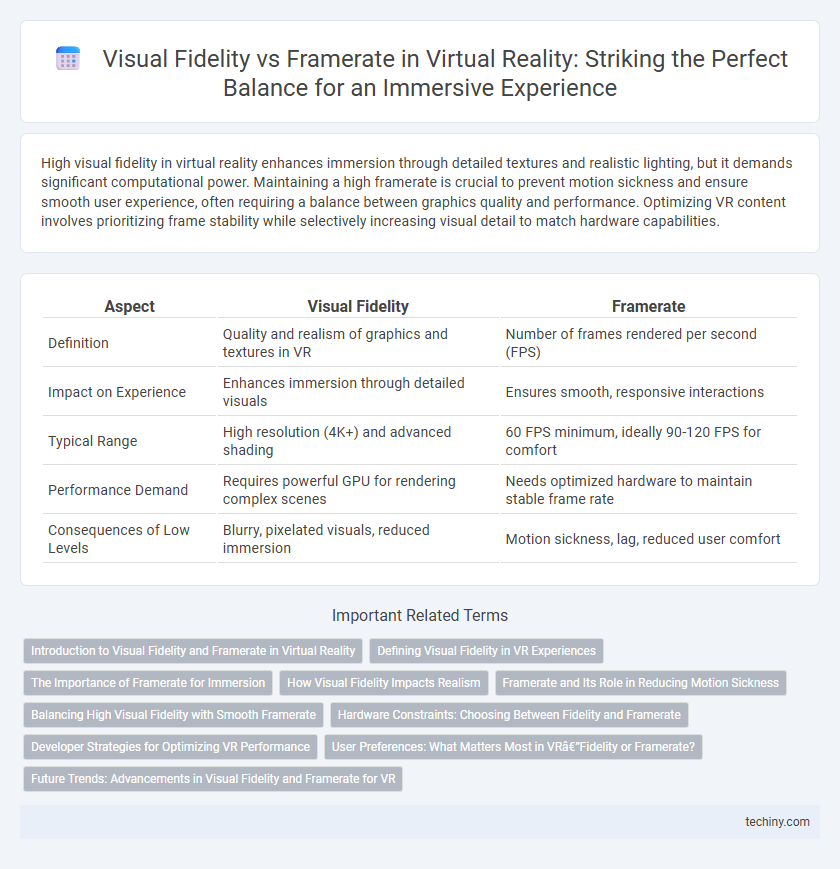High visual fidelity in virtual reality enhances immersion through detailed textures and realistic lighting, but it demands significant computational power. Maintaining a high framerate is crucial to prevent motion sickness and ensure smooth user experience, often requiring a balance between graphics quality and performance. Optimizing VR content involves prioritizing frame stability while selectively increasing visual detail to match hardware capabilities.
Table of Comparison
| Aspect | Visual Fidelity | Framerate |
|---|---|---|
| Definition | Quality and realism of graphics and textures in VR | Number of frames rendered per second (FPS) |
| Impact on Experience | Enhances immersion through detailed visuals | Ensures smooth, responsive interactions |
| Typical Range | High resolution (4K+) and advanced shading | 60 FPS minimum, ideally 90-120 FPS for comfort |
| Performance Demand | Requires powerful GPU for rendering complex scenes | Needs optimized hardware to maintain stable frame rate |
| Consequences of Low Levels | Blurry, pixelated visuals, reduced immersion | Motion sickness, lag, reduced user comfort |
Introduction to Visual Fidelity and Framerate in Virtual Reality
Visual fidelity in virtual reality refers to the clarity, detail, and realism of the virtual environment's graphics, significantly impacting user immersion. Framerate, measured in frames per second (FPS), determines how smoothly motion is rendered, with higher frame rates reducing motion sickness and enhancing responsiveness. Balancing visual fidelity and framerate is crucial for an optimal VR experience, as high-quality graphics demand more processing power, which can affect frame rate stability.
Defining Visual Fidelity in VR Experiences
Visual fidelity in VR experiences refers to the clarity, detail, and realism of virtual environments, including factors such as texture resolution, lighting quality, and object rendering accuracy. Higher visual fidelity enhances immersion by providing more lifelike and detailed scenes, which can significantly impact user experience and presence. Balancing visual fidelity with framerate is crucial since maintaining a smooth, high framerate (typically 90Hz or above) prevents motion sickness and ensures responsive interaction without compromising immersive detail.
The Importance of Framerate for Immersion
High framerate is crucial for immersion in virtual reality, as it ensures smooth and fluid motion, reducing motion sickness and enhancing realism. Visual fidelity contributes to detailed environments, but without a stable framerate of at least 90 frames per second, the experience can feel disjointed and uncomfortable. Prioritizing framerate maintains consistent interaction responsiveness, which is essential for a believable and engaging VR experience.
How Visual Fidelity Impacts Realism
High visual fidelity in virtual reality significantly enhances realism by providing detailed textures, accurate lighting, and lifelike environments that immerse users more deeply. However, maintaining high resolution and complex graphics can strain performance, potentially lowering the framerate and causing motion sickness or discomfort. Balancing visual fidelity with a stable framerate ensures smooth, believable experiences without compromising user comfort.
Framerate and Its Role in Reducing Motion Sickness
High framerate in virtual reality is critical for minimizing motion sickness by ensuring smooth and responsive visual updates that closely match head movements. Maintaining at least 90 frames per second reduces latency and motion blur, which are primary triggers of discomfort and disorientation in VR environments. Optimizing framerate stability enhances user immersion and comfort, directly impacting the effectiveness of VR applications.
Balancing High Visual Fidelity with Smooth Framerate
Achieving high visual fidelity in virtual reality requires detailed textures, advanced lighting, and realistic models, which can demand significant GPU resources. Smooth framerate, typically 90 FPS or higher, is essential to prevent motion sickness and maintain immersion, making performance optimization crucial. Balancing these involves prioritizing efficient rendering techniques like foveated rendering and dynamic resolution scaling to deliver crisp visuals without sacrificing fluid motion.
Hardware Constraints: Choosing Between Fidelity and Framerate
Hardware constraints in virtual reality often necessitate balancing visual fidelity and framerate to maintain immersive experiences. High-resolution textures and complex shaders enhance visual fidelity but demand significant GPU resources, which can reduce framerate, leading to motion sickness and discomfort. Optimal VR performance requires careful hardware optimization to deliver smooth frame rates, typically above 90 FPS, while preserving sufficient graphical detail within device limitations.
Developer Strategies for Optimizing VR Performance
Developers balance visual fidelity and framerate by implementing techniques such as dynamic resolution scaling and foveated rendering, which concentrate graphical resources where the user is looking while maintaining high performance. Leveraging asynchronous reprojection and efficient shader optimization further reduces latency and ensures smooth frame delivery at 90 FPS or higher, critical for immersive VR experiences. Profiling tools like Unity Profiler and Unreal Engine's GPU Visualizer guide precise adjustments to graphical settings without sacrificing user comfort or immersion.
User Preferences: What Matters Most in VR—Fidelity or Framerate?
User preferences in VR often balance visual fidelity and framerate, with many prioritizing smooth performance above ultra-high resolution to prevent motion sickness and enhance immersion. Studies indicate that a stable framerate of at least 90 FPS significantly improves user comfort and responsiveness, while lower framerates can cause latency and disorientation despite superior graphical quality. Developers optimize VR experiences by targeting the highest possible framerate without sacrificing essential visual details, tailoring to the user's sensitivity and application type.
Future Trends: Advancements in Visual Fidelity and Framerate for VR
Emerging VR technologies leverage AI-driven rendering techniques to enhance visual fidelity without compromising framerate, enabling ultra-realistic immersive experiences. Next-generation hardware, including advanced GPUs and high-refresh-rate displays, supports smoother motion and reduced latency, crucial for user comfort and presence. Innovations such as foveated rendering and real-time photorealistic shading optimize resource allocation, pushing the boundaries of VR realism and performance in tandem.
Visual fidelity vs Framerate Infographic

 techiny.com
techiny.com